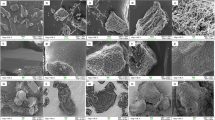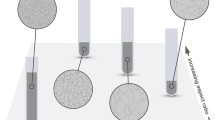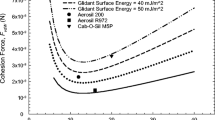Abstract
Purpose
To investigate the effect of dry coating the amount and type of silica on powder flowability enhancement using a comprehensive set of 19 pharmaceutical powders having different sizes, surface roughness, morphology, and aspect ratios, as well as assess flow predictability via Bond number estimated using a mechanistic multi-asperity particle contact model.
Method
Particle size, shape, density, surface energy and area, SEM-based morphology, and FFC were assessed for all powders. Hydrophobic (R972P) or hydrophilic (A200) nano-silica were dry coated for each powder at 25%, 50%, and 100% surface area coverage (SAC). Flow predictability was assessed via particle size and Bond number.
Results
Nearly maximal flow enhancement, one or more flow category, was observed for all powders at 50% SAC of either type of silica, equivalent to 1 wt% or less for both the hydrophobic R972P or hydrophilic A200, while R972P generally performed slightly better. Silica amount as SAC better helped understand the relative performance. The power-law relation between FFC and Bond number was observed.
Conclusion
Significant flow enhancements were achieved at 50% SAC, validating previous models. Most uncoated very cohesive powders improved by two flow categories, attaining easy flow. Flowability could not be predicted for both the uncoated and dry coated powders via particle size alone. Prediction was significantly better using Bond number computed via the mechanistic multi-asperity particle contact model accounting for the particle size, surface energy, roughness, and the amount and type of silica. The widely accepted 200 nm surface roughness was not valid for most pharmaceutical powders.








Similar content being viewed by others
References
Prescott JK, Garcia TP. A solid dosage and blend content uniformity troubleshooting diagram. Pharm Technol North Am. 2001;25(3):68–88.
Jallo LJ, Ghoroi C, Gurumurthy L, Patel U, Davé RN. Improvement of flow and bulk density of pharmaceutical powders using surface modification. Int J Pharm. 2012;423(2):213–25.
Ghoroi C, Gurumurthy L, McDaniel DJ, Jallo LJ, Davé RN. Multi-faceted characterization of pharmaceutical powders to discern the influence of surface modification. Powder Technol. 2013;236:63–74.
Huang Z, Xiong W, Kunnath K, Bhaumik S, Davé RN. Improving blend content uniformity via dry particle coating of micronized drug powders. Eur J Pharm Sci. 2017;104:344–55.
Guerin E, Tchoreloff P, Leclerc B, Anguy TD, Deleuil M, Couarraze G. Rheological characterization of pharmaceutical powders using tap testing, shear cell and mercury porosimeter. Int J Pharm. 1999;189(1):12.
Nase ST, Vargas WL, Abatan AA, McCarthy JJ. Discrete characterization tools for cohesive granular material. Powder Technol. 2001;116(2–3):214–223.
Jallo LJ, Chen Y, Bowen J, Etzler F, Dave R. Prediction of inter-particle adhesion force from surface energy and surface roughness. J Adhes Sci Technol. 2011;25(4–5):367–84.
Kunnath K, Chen L, Zheng K, Davé RN. Assessing predictability of packing porosity and bulk density enhancements after dry coating of pharmaceutical powders. Powder Technol. 2021;377:709–22.
Podczeck F, Miah Y. The influence of particle size and shape on the angle of internal friction and the flow factor of unlubricated and lubricated powders. Int J Pharm. 1996;144(2):187–94.
Jallo LJ, Schoenitz M, Dreizin EL, Dave RN, Johnson CE. The effect of surface modification of aluminum powder on its flowability, combustion and reactivity. Powder Technol. 2010;204(1):63–70.
Hou H, Sun CC. Quantifying effects of particulate properties on powder flow properties using a ring shear tester. J Pharm Sci. 2008;97(9):9.
Kachrimanis K, Karamyan V, Malamataris S. Artificial neural networks (ANNs) and modeling of powder flow. Int J Pharm. 2003;250(1):13–23.
Bertuola D, Volpato S, Canu P, Santomaso AC. Prediction of segregation in funnel and mass flow discharge. Chem Eng Sci. 2016;150:16–25.
Polizzi MA, Franchville J, Hilden JL. Assessment and predictive modeling of pharmaceutical powder flow behavior in small-scale hoppers. Powder Technol. 2016;294:30–42.
Antikainen OK, Rantanen JT, Yliruusi J. Use of the Kohonen self-organising map to predict the flowability of powders. STP Pharma Sci. 2000;10(5):349–54.
Guo A, Beddow JK, Vetter AF. A simple relationship between particle shape effects and density, flow rate and Hausner ratio. Powder Technol. 1985;43(3):279–84.
Mullarney MP, Leyva N. Modelling pharmaceutical powder flow performance using particle size distribution. Pharmaceutical Technology. 2009;33:126–34.
Sandler N, Wilson D. Prediction of granule packing and flow behavior based on particle size and shape analysis. J Pharm Sci. 2010;99(2):958–68.
Wang Y, Snee RD, Meng W, Muzzio FJ. Predicting flow behavior of pharmaceutical blends using shear cell methodology: a quality by design approach. Powder Technol. 2016;294(Supplement C):22–9.
Yu W, Muteki K, Zhang L, Kim G. Prediction of bulk powder flow performance using comprehensive particle size and particle shape distributions. J Pharm Sci. 2011;100(1):284–93.
Yu AB, Feng CL, Zou RP, Yang RY. On the relationship between porosity and interparticle forces. Powder Technol. 2003;130(1–3):70–6.
Chen Y, Yang J, Dave RN, Pfeffer R. Fluidization of coated group C powders. AICHE J. 2008;54(1):104–21.
Castellanos A. The relationship between attractive interparticle forces and bulk behaviour in dry and uncharged fine powders. Adv Phys. 2005;54(4):263–376.
Chen Y, Jallo L, Quintanilla MAS, Dave RN. Characterization of particle and bulk level cohesion reduction of surface modified fine aluminum powders. Colloids Surf A Physicochem Eng Asp. 2010;361(1–3):14.
Schulze D. Powders and bulk solids: behavior, characterization, storage and flow. Berlin Heidelberg: Springer; 2007.
Capece M, Ho R, Strong J, Gao P. Prediction of powder flow performance using a multi-component granular bond number. Powder Technol. 2015;286:561–71.
Capece M, Huang Z, To D, Aloia M, Muchira C, Davé RN, Yu AB. Prediction of porosity from particle scale interactions: surface modification of fine cohesive powders. Powder Technol. 2014;254:103–13.
Yang J, Sliva A, Banerjee A, Dave RN, Pfeffer R. Dry particle coating for improving the flowability of cohesive powders. Powder Technol. 2005;158(1–3):21–33.
Vercruysse J, Delaet U, Van Assche I, Cappuyns P, Arata F, Caporicci G, De Beer T, Remon JP, Vervaet C. Stability and repeatability of a continuous twin screw granulation and drying system. Eur J Pharm Biopharm. 2013;85(3):7.
Van Snick B, Holman J, Vanhoorne V, Kumar A, De Beer T, Remon JP, Vervaet C. Development of a continuous direct compression platrom for low-dose drug products. Int J Pharm. 2017;529(1–2):17.
Simonaho S-P, Ketolainen J, Ervasti T, Toiviainen M, Korhonen O. Continuous manufacturing of tablets with PROMIS-line — introduction and case studies from continuous feeding, blending and tableting. Eur J Pharm Sci. 2016;90:38–46.
Huang Z, Scicolone JV, Gurumuthy L, Davé RN. Flow and bulk density enhancements of pharmaceutical powders using a conical screen mill: a continuous dry coating device. Chem Eng Sci. 2015b;125:209–24.
Kim S, Bilgili E, Davé RN. Impact of altered hydrophobicity and reduced agglomeration on dissolution of micronized poorly water-soluble drug powders after dry coating. International Journal of Pharmaceutics. 2021;606.
Chen H, Aburub A, Sun CC. Direct compression tablet containing 99% active ingredient—a tale of spherical crystallization. J Pharm Sci. 2019;108(4):1396–400.
Huang Z, Scicolone JV, Han X, Davé RN. Improved blend and tablet properties of fine pharmaceutical powders via dry particle coating. Int J Pharm. 2015a;478(2):447–55.
Kunnath K, Huang Z, Chen L, Zheng K, Davé R. Improved properties of fine active pharmaceutical ingredient powder blends and tablets at high drug loading via dry particle coating. Int J Pharm. 2018;543(1–2):288–99.
Mullarney MP, Beach LE, Davé RN, Langdon BA, Polizzi M, Blackwood DO. Applying dry powder coatings to pharmaceutical powders using a comil for improving powder flow and bulk density. Powder Technol. 2011a;212(3):397–402.
Han X, Ghoroi C, To D, Chen Y, Davé R. Simultaneous micronization and surface modification for improvement of flow and dissolution of drug particles. Int J Pharm. 2011;415(1–2):185–95.
Chen Y, Quintanilla MAS, Yang J, Valverde JM, Dave RN. Pull-off force of coated fine powders under small consolidation. Physical Review E. 2009;79(4):041305.
Chen Y, Quintanilla MAS, Yang J, Valverde JM, Dave RN. Pull-off force of coated fine powders under small consolidation. Phys Rev E. 2009;79(4):041305.
Kim S. C. Cheikhali, Dave RN. Decoding fine API agglomeration as a key indicator of powder flowability and dissolution: impact of particle engineering. Pharm Res. 2022a;20
Deng X, Davé RN. Adhesion and friction of dry-coated nano-rough particles. Powder Technol. 2017;314:20–7.
Ma B, Jiang Q, Huang J, Wang X, Leng J. Effect of different silica particles on flowability of gypsum powder for 3D powder printing. Constr Build Mater. 2019;217:394–402.
Jonat S, Hasenzahl S, Drechsler M, Albers P, Wagner KG, Schmidt PC. Investigation of compacted hydrophilic and hydrophobic colloidal silicon dioxides as glidants for pharmaceutical excipients. Powder Technol. 2004;141(1):31–43.
Kojima T, Elliott JA. Effect of silica nanoparticles on the bulk flow properties of fine cohesive powders. Chem Eng Sci. 2013;101:315–28.
Kim S, Bilgili E, Davé RN. Impact of altered hydrophobicity and reduced agglomeration on dissolution of micronized poorly water-soluble drug powders after dry coating. Int J Pharm. 2021;606:120853.
Chen L, Ding X, He Z, Fan S, Kunnath KT, Zheng K, Davé RN. Surface engineered excipients: II. Simultaneous milling and dry coating for preparation of fine-grade microcrystalline cellulose with enhanced properties. Int J Pharm. 2018;546(1):125–36.
Chen L, Ding X, He Z, Huang Z, Kunnath KT, Zheng K, Davé RN. Surface engineered excipients: I. improved functional properties of fine grade microcrystalline cellulose. Int J Pharm. 2018;536(1):127–37.
Chen L, He Z, Kunnath K, Zheng K, Kim S, Davé RN. Fine grade engineered microcrystalline cellulose excipients for direct compaction: assessing suitability of different dry coating processes. Eur J Pharm Sci. 2020;151:105408.
Chen L, He Z, Kunnath KT, Fan S, Wei Y, Ding X, Zheng K, Davé RN. Surface engineered excipients: III. Facilitating direct compaction tableting of binary blends containing fine cohesive poorly-compactable APIs. Int J Pharm. 2019;557:354–65.
Han X, Ghoroi C, Davé R. Dry coating of micronized API powders for improved dissolution of directly compacted tablets with high drug loading. Int J Pharm. 2013;442(1):74–85.
Giraud M, Gatumel C, Vaudez S, Bernard-Granger G, Nos J, Gervais T, Berthiaux H. Investigation of a granular bond number based rheological model for polydispersed particulate systems. Chem Eng Sci. 2020;228:16.
Massimilla L, Donsì G. Cohesive forces between particles of fluid-bed catalysts. Powder Technol. 1976;15(2):253–60.
Davé R, Kim S, Kunnath K, Tripathi S. A concise treatise on model-based enhancements of cohesive powder properties via dry particle coating. Advanced Powder Technology. 2022;33(11):103836.
Han X, Jallo L, To D, Ghoroi C, Davé R. Passivation of high-surface-energy sites of milled ibuprofen crystals via dry coating for reduced cohesion and improved flowability. J Pharm Sci. 2013b;102(7):2282–96.
Yu W, Hancock BC. Evaluation of dynamic image analysis for characterizing pharmaceutical excipient particles. Int J Pharm. 2008;361(1–2):150–7.
Yu W, Muteki K, Zhang L, Kim G. Prediction of Bulk Powder Flow Performance Using Comprehensive Particle Size and Particle Shape Distributions. Journal of Pharmaceutical Sciences. 2011;100(1):284–293.
Yu W, Liao L, Bharadwaj R, Hancock BC. What is the "typical" particle shape of active pharmaceutical ingredients? Powder Technol. 2017;313:7.
Freeman R. Measuring the flow properties of consolidated, conditioned and aerated powders — a comparative study using a powder rheometer and a rotational shear cell. Powder Technol. 2007;174(1):25–33.
Kim SS, C. Castillo, M. Sayedahmed, Dave RN. Reduced fine API agglomeration after dry coating for enhanced blend uniformity and processability of low drug loaded blends Pharm Res. 2022b;39:19.
Capece M, Silva KR, Sunkara D, Strong J, Gao P. On the relationship of inter-particle cohesiveness and bulk powder behavior: Flowability of pharmaceutical powders. Int J Pharm. 2016;511(1):178–89.
Acknowledgments
The authors thank Zhixing Lin for his valuable input during the writing of this paper.
Funding
The authors are thankful for financial support from National Science Foundation under grant IIP-1919037, IIP-2137209. RND gratefully acknowledges International Fine Particle Research Institute’s (IFPRI) financial support.
Author information
Authors and Affiliations
Contributions
Kuriakose T. Kunnath: Conceptualization (equal); Writing – original draft (lead); Methodology; Investigation; Validation; Data Curation; Formal analysis; Visualization.
Siddharth Tripathi: Data Curation; Formal analysis; Visualization; Writing – review & editing.
Sangah S. Kim: Writing – review & editing.
Liang Chen: Supervision (support).
Kai Zheng: Supervision (support).
Rajesh N. Dave: Funding Acquisition (lead); Conceptualization (equal); Writing – review, editing and rewriting (lead); Data curation (equal); Formal Analysis (equal); Supervision (lead).
Corresponding author
Ethics declarations
Conflict of Interest
The authors have no conflicts of interest or sources of competing interest to declare.
Additional information
Publisher’s Note
Springer Nature remains neutral with regard to jurisdictional claims in published maps and institutional affiliations.
Highlights
• Flow improved by 1+ regimes via dry coating for all 19 APIs/excipients (5-200 mm).
• 50 %SAC silica (1 wt% or less) led to optimal flow (FFC) increase for all powders.
• Hydrophobic-R972P and hydrophilic-A200 silica perform well, R972P slightly better.
• The granular Bond number better predicts flowability/FFC than the particle size.
• Surface roughness is a dominant factor for flow, 200 nm value not universally valid.
Supplementary Information
ESM 1
(DOCX 15 kb)
Rights and permissions
Springer Nature or its licensor (e.g. a society or other partner) holds exclusive rights to this article under a publishing agreement with the author(s) or other rightsholder(s); author self-archiving of the accepted manuscript version of this article is solely governed by the terms of such publishing agreement and applicable law.
About this article
Cite this article
Kunnath, K.T., Tripathi, S., Kim, S.S. et al. Selection of Silica Type and Amount for Flowability Enhancements via Dry Coating: Contact Mechanics Based Predictive Approach. Pharm Res 40, 2917–2933 (2023). https://doi.org/10.1007/s11095-023-03561-6
Received:
Accepted:
Published:
Issue Date:
DOI: https://doi.org/10.1007/s11095-023-03561-6




